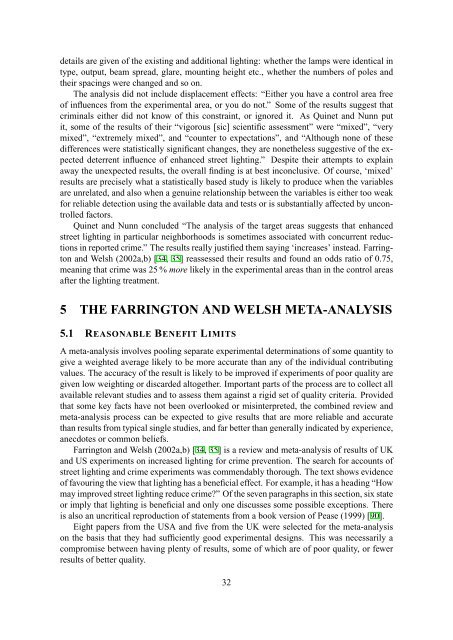outdoor lighting and crime, part 1 - Astronomical Society of Victoria
outdoor lighting and crime, part 1 - Astronomical Society of Victoria
outdoor lighting and crime, part 1 - Astronomical Society of Victoria
You also want an ePaper? Increase the reach of your titles
YUMPU automatically turns print PDFs into web optimized ePapers that Google loves.
details are given <strong>of</strong> the existing <strong>and</strong> additional <strong>lighting</strong>: whether the lamps were identical in<br />
type, output, beam spread, glare, mounting height etc., whether the numbers <strong>of</strong> poles <strong>and</strong><br />
their spacings were changed <strong>and</strong> so on.<br />
The analysis did not include displacement effects: “Either you have a control area free<br />
<strong>of</strong> influences from the experimental area, or you do not.” Some <strong>of</strong> the results suggest that<br />
criminals either did not know <strong>of</strong> this constraint, or ignored it. As Quinet <strong>and</strong> Nunn put<br />
it, some <strong>of</strong> the results <strong>of</strong> their “vigorous [sic] scientific assessment” were “mixed”, “very<br />
mixed”, “extremely mixed”, <strong>and</strong> “counter to expectations”, <strong>and</strong> “Although none <strong>of</strong> these<br />
differences were statistically significant changes, they are nonetheless suggestive <strong>of</strong> the expected<br />
deterrent influence <strong>of</strong> enhanced street <strong>lighting</strong>.” Despite their attempts to explain<br />
away the unexpected results, the overall finding is at best inconclusive. Of course, ‘mixed’<br />
results are precisely what a statistically based study is likely to produce when the variables<br />
are unrelated, <strong>and</strong> also when a genuine relationship between the variables is either too weak<br />
for reliable detection using the available data <strong>and</strong> tests or is substantially affected by uncontrolled<br />
factors.<br />
Quinet <strong>and</strong> Nunn concluded “The analysis <strong>of</strong> the target areas suggests that enhanced<br />
street <strong>lighting</strong> in <strong>part</strong>icular neighborhoods is sometimes associated with concurrent reductions<br />
in reported <strong>crime</strong>.” The results really justified them saying ‘increases’ instead. Farrington<br />
<strong>and</strong> Welsh (2002a,b) [34, 35] reassessed their results <strong>and</strong> found an odds ratio <strong>of</strong> 0.75,<br />
meaning that <strong>crime</strong> was 25 % more likely in the experimental areas than in the control areas<br />
after the <strong>lighting</strong> treatment.<br />
5 THE FARRINGTON AND WELSH META-ANALYSIS<br />
5.1 REASONABLE BENEFIT LIMITS<br />
A meta-analysis involves pooling separate experimental determinations <strong>of</strong> some quantity to<br />
give a weighted average likely to be more accurate than any <strong>of</strong> the individual contributing<br />
values. The accuracy <strong>of</strong> the result is likely to be improved if experiments <strong>of</strong> poor quality are<br />
given low weighting or discarded altogether. Important <strong>part</strong>s <strong>of</strong> the process are to collect all<br />
available relevant studies <strong>and</strong> to assess them against a rigid set <strong>of</strong> quality criteria. Provided<br />
that some key facts have not been overlooked or misinterpreted, the combined review <strong>and</strong><br />
meta-analysis process can be expected to give results that are more reliable <strong>and</strong> accurate<br />
than results from typical single studies, <strong>and</strong> far better than generally indicated by experience,<br />
anecdotes or common beliefs.<br />
Farrington <strong>and</strong> Welsh (2002a,b) [34, 35] is a review <strong>and</strong> meta-analysis <strong>of</strong> results <strong>of</strong> UK<br />
<strong>and</strong> US experiments on increased <strong>lighting</strong> for <strong>crime</strong> prevention. The search for accounts <strong>of</strong><br />
street <strong>lighting</strong> <strong>and</strong> <strong>crime</strong> experiments was commendably thorough. The text shows evidence<br />
<strong>of</strong> favouring the view that <strong>lighting</strong> has a beneficial effect. For example, it has a heading “How<br />
may improved street <strong>lighting</strong> reduce <strong>crime</strong>?” Of the seven paragraphs in this section, six state<br />
or imply that <strong>lighting</strong> is beneficial <strong>and</strong> only one discusses some possible exceptions. There<br />
is also an uncritical reproduction <strong>of</strong> statements from a book version <strong>of</strong> Pease (1999) [90].<br />
Eight papers from the USA <strong>and</strong> five from the UK were selected for the meta-analysis<br />
on the basis that they had sufficiently good experimental designs. This was necessarily a<br />
compromise between having plenty <strong>of</strong> results, some <strong>of</strong> which are <strong>of</strong> poor quality, or fewer<br />
results <strong>of</strong> better quality.<br />
32
















